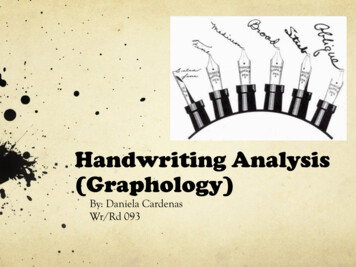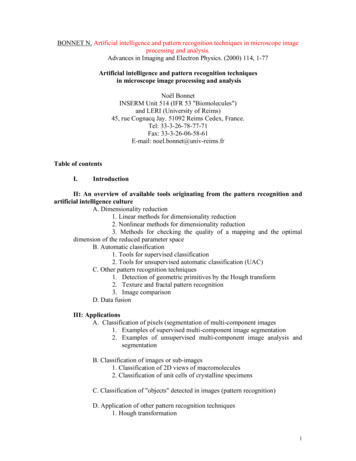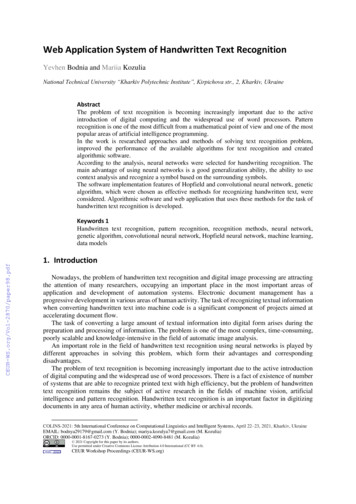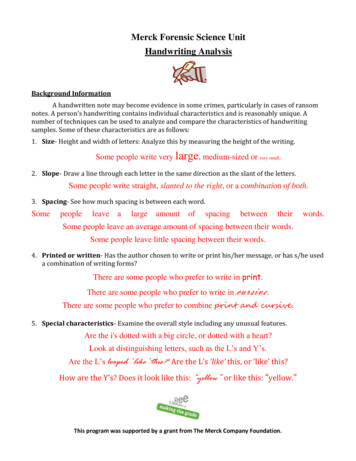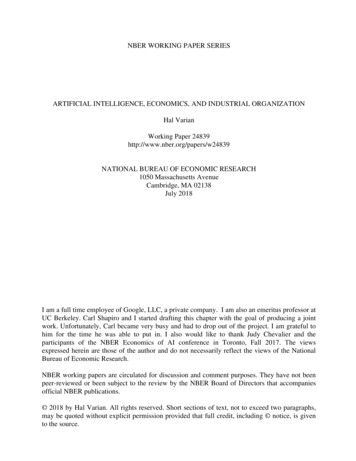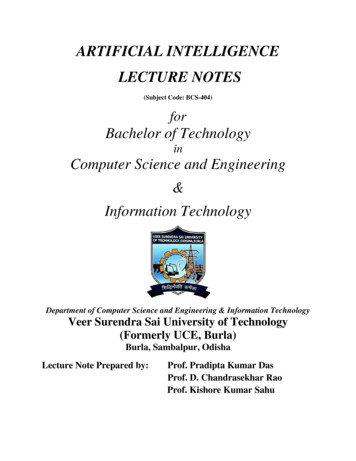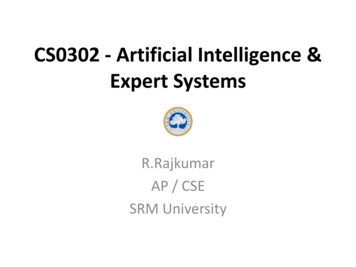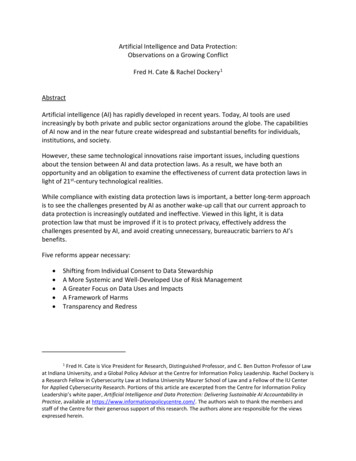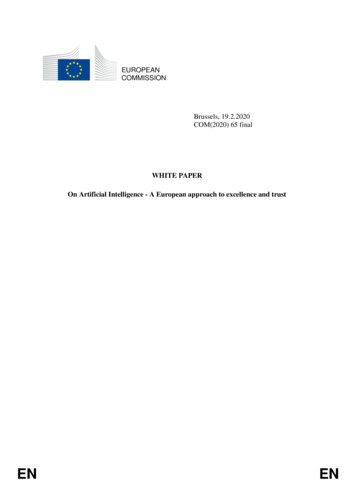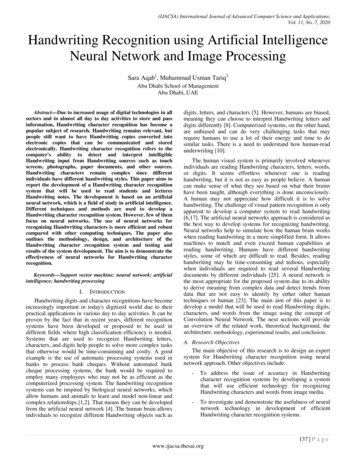
Transcription
(IJACSA) International Journal of Advanced Computer Science and Applications,Vol. 11, No. 7, 2020Handwriting Recognition using Artificial IntelligenceNeural Network and Image ProcessingSara Aqab1, Muhammad Usman Tariq2Abu Dhabi School of ManagementAbu Dhabi, UAEAbstract—Due to increased usage of digital technologies in allsectors and in almost all day to day activities to store and passinformation, Handwriting character recognition has become apopular subject of research. Handwriting remains relevant, butpeople still want to have Handwriting copies converted intoelectronic copies that can be communicated and storedelectronically. Handwriting character recognition refers to thecomputer's ability to detect and interpret intelligibleHandwriting input from Handwriting sources such as touchscreens, photographs, paper documents, and other sources.Handwriting characters remain complex since differentindividuals have different handwriting styles. This paper aims toreport the development of a Handwriting character recognitionsystem that will be used to read students and lecturesHandwriting notes. The development is based on an artificialneural network, which is a field of study in artificial intelligence.Different techniques and methods are used to develop aHandwriting character recognition system. However, few of themfocus on neural networks. The use of neural networks forrecognizing Handwriting characters is more efficient and robustcompared with other computing techniques. The paper alsooutlines the methodology, design, and architecture of theHandwriting character recognition system and testing andresults of the system development. The aim is to demonstrate theeffectiveness of neural networks for Handwriting characterrecognition.Keywords—Support vector machine; neural network; artificialintelligence; handwriting processingI.INTRODUCTIONHandwriting digits and character recognitions have becomeincreasingly important in today's digitized world due to theirpractical applications in various day to day activities. It can beproven by the fact that in recent years, different recognitionsystems have been developed or proposed to be used indifferent fields where high classification efficiency is needed.Systems that are used to recognize Handwriting letters,characters, and digits help people to solve more complex tasksthat otherwise would be time-consuming and costly. A goodexample is the use of automatic processing systems used inbanks to process bank cheques. Without automated bankcheque processing systems, the bank would be required toemploy many employees who may not be as efficient as thecomputerized processing system. The handwriting recognitionsystems can be inspired by biological neural networks, whichallow humans and animals to learn and model non-linear andcomplex relationships [1,2]. That means they can be developedfrom the artificial neural network [4]. The human brain allowsindividuals to recognize different Handwriting objects such asdigits, letters, and characters [5]. However, humans are biased,meaning they can choose to interpret Handwriting letters anddigits differently [8]. Computerized systems, on the other hand,are unbiased and can do very challenging tasks that mayrequire humans to use a lot of their energy and time to dosimilar tasks. There is a need to understand how human-readunderwriting [10].The human visual system is primarily involved wheneverindividuals are reading Handwriting characters, letters, words,or digits. It seems effortless whenever one is readinghandwriting, but it is not as easy as people believe. A humancan make sense of what they see based on what their brainshave been taught, although everything is done unconsciously.A human may not appreciate how difficult it is to solvehandwriting. The challenge of visual pattern recognition is onlyapparent to develop a computer system to read handwriting[6,17]. The artificial neural networks approach is considered asthe best way to develop systems for recognizing handwriting.Neural networks help to simulate how the human brain workswhen reading handwriting in a more simplified form. It allowsmachines to match and even exceed human capabilities atreading handwriting. Humans have different handwritingstyles, some of which are difficult to read. Besides, readinghandwriting may be time-consuming and tedious, especiallywhen individuals are required to read several Handwritingdocuments by different individuals [25]. A neural network isthe most appropriate for the proposed system due to its abilityto derive meaning from complex data and detect trends fromdata that are not easy to identify by either other humantechniques or human [23]. The main aim of this paper is todevelop a model that will be used to read Handwriting digits,characters, and words from the image using the concept ofConvolution Neural Network. The next sections will providean overview of the related work, theoretical background, thearchitecture, methodology, experimental results, and conclusion.A. Research ObjectivesThe main objective of this research is to design an expertsystem for Handwriting character recognition using neuralnetwork approach. Other objectives include:-To address the issue of accuracy in Handwritingcharacter recognition systems by developing a systemthat will use efficient technology for recognizingHandwriting characters and words from image media.-To investigate and demonstrate the usefulness of neuralnetwork technology in development of efficientHandwriting character recognition systems.137 P a g ewww.ijacsa.thesai.org
(IJACSA) International Journal of Advanced Computer Science and Applications,Vol. 11, No. 7, 2020B. Research QuestionsThis research is aimed to answer the following questions: What are the different techniques and methods used inHandwriting character recognition? How can the performance of Handwriting recognitionsystems be improved using artificial neural networks?C. Target GroupThis paper will be targeting university students andinstructors who want to convert their Handwriting notes andpapers into electronic format. Despite the increased adoption ofdigital technology in institutions of higher education,handwriting remains part of students' and instructors' dailylives. Students take Handwriting notes while listening to theirlectures and take notes while reading from different sources.Some also note down their thoughts, plans, and ideas on theirnotes. Likewise, lecturers have Handwriting notes that theywould want to communicate to students. Hence, this paper willbe targeting students and lecturers to develop a system that willallow them to convert their Handwriting works into electronicworks that can be stored and communicated electronically. Thecentral assumption of this paper is that students and lecturersneed to have copies of their works that are stored electronicallyin their personal computers. Further, handwriting with pen andpaper cannot be entirely replaced by digital technology.II. THEORETICAL BACKGROUNDHandwriting character recognition is one of the researchfields in computer vision, artificial intelligence, and patternrecognition [3,9]. A computer application that performshandwriting recognition can be argued to have the ability toacquire and detecting characters in pictures, paper documents,and other sources and convert them into electronic format ormachine-encoded form. The system may obtain Handwritingsources from a piece of paper through optical scanning orintelligent word recognition. Also, the system may be designedto detect the movement of the pen tip on the screen. In otherwords, handwriting recognition may involve a system detectingmovements of a pen tip on the screen to get a clue of thecharacters being written [7]. Handwriting recognition can beclassified into two: offline recognition and online recognition.Offline handwriting recognition involved the extraction of textor characters from an image to have letter codes that can beused within a computer [15]. It involves obtaining digital datafrom a static representation of handwriting. A system isprovided with a Handwriting document to read and convert thehandwriting to a digital format. Online handwritingrecognition, on the other hand, involved automatic detection orconversion of characters as they are written on the specializedscreen [28, 35]. In this case, the system sensors movement ofpen-tip to detect characters and words. Different methods andtechniques are used to ensure that computer systems can readcharacters from Handwriting images and documents [32, 26].Among the existing techniques that are used to model, andtrain Handwriting character recognition include neuralnetwork, Hidden Markov Model (HMM), Machine Learning,and Support Vector Machine, to mention a few. This paperfocuses on artificial intelligence networks, machine learning,Hidden Markov Model, and the Support Vector Machine.A. Artificial IntelligenceThe idea of reading Handwriting characters, digits, andwords by computer systems can be argued to be an imitation ofa human being. In other words, such a system can be arguedthat they use artificial intelligence to read handwriting fromimages or any Handwriting source [11]. Artificial intelligencerefers to intelligence that is demonstrated by machines [13].The term is used to describe computer or machines that canmimic "cognitive" functions that are associated with the humanmind. Artificial intelligence allows the machine to learn fromexperience, adjust to new data (inputs), and perform tasks thatcan be performed by humans [12, 20]. Branches of artificialintelligence include machine learning, neuron network, anddeep learning.B. Machine LearningMachine learning technology is inspired by psychology andbiology that focus on learning from a set of data. The centralassumption is that machines can learn to perform given tasksby learning from data [21]. A machine learning model isprovided with training data that is specific to the given problemdomain and the solution to each instance of the problem. Thatway, the model learns how to solve certain problems based onlearning [14]. Fig. 1 shows a simple demonstration of themachine learning model used in the handwriting recognitionsystem. The model takes an image that has a Handwriting digitand determines the specific digit based on the learning data.C. Artificial Neural Network (ANN)Artificial Neural Network (ANN) refers to informationprocessing paradigm or computing systems that are inspired bybiological neural networks that constitute the human brain [18].The systems are not identical to the biological neural systems,but they are designed to process information the same way thehuman brain and animal brain process information [27]. Thenetworks are composed of many interconnected neuronsworking in unison to achieve specific goals [37]. Just like thehuman brain, ANN learns from example. Hence, an ANN canbe configured for an application, such as data classification orcharacter recognition through the learning process. Thelearning process involves adjusting the system to a connection[24]. The artificial neural network comprises a network ofmultiple simple processors, each with a small amount of localmemory [39]. The processors (units) are linked together byunidirectional communication channels and operates only onlocal data and input their get through their links.D. Biological Neuron and ANNAs indicated earlier, artificial neural networks are inspiredby the biological neural system. Hence, learning howbiological neurons works can help to understand the artificialneural network [16]. The human body's neural system consistsof three stages: neural network, receptors, and effectors asshown in Fig. 2. The first phase is the receptor which receivesstimuli from the external or internal environment and thenpasses the information to neurons [14, 16]. The second phaseinvolves the processing of information by the neural network tomake a proper decision of output. The third and final stageinvolves translation of the electrical impulses into responses tothe external environment.138 P a g ewww.ijacsa.thesai.org
(IJACSA) International Journal of Advanced Computer Science and Applications,Vol. 11, No. 7, 2020Fig. 1. Machine Learning Handwriting Model.Fig. 5. Complicated Neuron Model.Fig. 2. Biological Neuron Model.An artificial neural network can be argued to be asimplified imitation of the central nervous system. Thestructural constituents of human brains known as neuronsperform computations such as logical inference, cognition, andpattern recognition, to mention a [19, 38].The neuron models are shown in Fig. 3 and 4; however,does not do anything different that cannot be done byconventional computers. In other words, it is just a simplerepresentation of a neural network system that does not domuch different from what a traditional computer can do. TheFig. 5 presents a more complicated model (McCulloch andPitts Model) which is different from the previous model sinceit has inputs that are "weighted" [17]. That means each inputhas a different effect on decision making. The weight of aninput can be described as the number which when multipliedwith the input, it results in weighted input [39]. The results arethen added together, and if they exceed the certain predetermined threshold value, the neuron fires, else, the neurondoes not fire [29, 33].Mathematically, neuron fires if and only if: X1Y1 X2Y2 Threshold. The McCulloch and Pitts Model (MCP)neuron can adapt to different situations by changing its weightsand/or threshold [17]. Various algorithms can be used to makeneurons to "adapt," with Delta rule and the back-errorpropagation being the most used algorithms.E. Deep Neural NetworkThe neural network has layers of units where each layertakes some value from the previous layer. That way, systemsthat are based on neural networks can compute inputs to get theneeded output [29]. The same way neurons pass signals aroundthe brain, and values are passed from one unit in an artificialneural network to another to perform the required computationand get new value as output [17]. The united are layers,forming a system that starts from the layers used for imputingto layer that is used to provide the output. The layers that arefound between the input and output layers are called the hiddenlayer. The hidden layers refer to a deep neural network that isused for computation of the values inputted in the input layer.The term "deep" is used to refer to the hidden layers of theneural network [25] as shown in Fig. 6. In Handwritingcharacter recognition systems, the deep neural network isinvolved in learning the characters to be recognized fromHandwriting images [33]. With enough training data, the deepneural network can be able to perform any function that aneural network is supposed to do. It is only possible if theneural network has enough hidden layers, although the smallerdeep neural network is more computationally efficient than amore extensive deep neural network [19].Fig. 3. Neuron Model.Fig. 6. Deep Neural Network.Fig. 4. Artificial Neuron Model.F. Hidden Markov Models (HMM)Hidden Markov Model (HMM) has been used in manyhandwriting recognition systems as a primary modelingcomponent. It is essential to examine the theoreticalbackground of this model to have a clear understanding of how139 P a g ewww.ijacsa.thesai.org
(IJACSA) International Journal of Advanced Computer Science and Applications,Vol. 11, No. 7, 2020handwriting recognition systems work [31]. HMM is astatistical Markov model that is used in a system that issupposed to assume the Markov process [40]. It can beconsidered as the most straightforward dynamic Bayesiannetwork. Hidden Markov Models are class pf probabilisticgraphical models used for predicting a sequence of hiddenvariables from a set of observed variables [15]. For instance,these types of models can be used to predict the weather basedon the types of people's clothing. The weather, in this case, isthe hidden variable while the people's clothes are what hasbeen observed (known) [40]. In the same way, HMMs havesuccessfully been implemented in the speech recognition, andcharacter recognition since the models can help systems topredict unknown from the observed [23]. The fact thathandwriting can be a statistical model is the main reason HMMcan be argued to be one of the most preferred models in thedevelopment of Handwriting character recognition systems[30].that is dependent on learning algorithms for classification andregression analysis. A support vector machine can beconsidered as a computational algorithm that finds out a hyperplane or a line in a multidimensional space that separateclasses. The separation between two or more linear classes canbe achieved by any hyperplane [2,17]. This method is knownas linear classification. However, several hyperplanes can beused to classify the same set of data, as shown in Fig. 7. Asupport vector machine is an approach where the main aim isto find the best separation hyperplane.The comparison of all approaches is shown in Table Ibelow.G. Support Vector MachineHandwriting recognition can be considered as a problem ofsupervised learning and classification from a discriminativeclassifier point of view, with this assumption, Support VectorMachine which a discriminative classifier is considered as oneof the models that can be effective in developing handwritingrecognition systems [34]. Like a neural network, a supportvector machine is a subset of machine learning [36]. Thesupport vector machine refers to a supervised learning modelTABLE I.Fig. 7. Support Vector Machine Hyperplane.COMPARISON OF agesHidden Markov Models(HMM)HMM is a statistical Markovmodel which is used in a systemthat is supposed to assume theMarkov process-Strong statistical foundation [31].-It allows a flexible generalization of sequenceprofiles [40]-Have many unstructured parameters.-Algorithms are expensive in terms ofcomputational time and memory [15]-Training requires repeated iterations,and this can be time-consuming [19]Machine LearningMachine learning-poweredsystems rely on patterns andinference instead of explicitinstruction to read text andcharacters [21]-No human intervention needed [27].-Allows continuous improvement [19]-Requires massive data to train [21]-Expensive in terms of time andresources [27]-High-error susceptibility [31]Neural NetworkA neural network can beconsidered as a large parallelcomputing system comprising ofmany interconnected nodes.-Can learn complex non-linear inputrelationships [35].-Has self-organizing capability [16].-Ability to work with incomplete knowledge-Parallel processing capability-Ability to make machine learningDifferent training may damage thecapability of the systemOverreliance on hardware [22]Support Vector Machines(SVM)Classifies the data using ahyperplaneUnlike neural networks, SVM approach relieson learning examples and structural behavior[23].Has better generalization due to structural riskminimizationIt is difficult to select a "good" kernelfunctionDifficult to understand and interpretIt is hard to visualize the impact ofSVM models.140 P a g ewww.ijacsa.thesai.org
(IJACSA) International Journal of Advanced Computer Science and Applications,Vol. 11, No. 7, 2020IV. DESIGN AND ARCHITECTUREThis section discusses the design and architecture of theproposed handwritten character recognition system that will beusing the neural network approach. The proposed systemcomprises input pre-processing, CNN, and output sections asshown in Fig. 8.Fig. 8. Handwriting Recognition System (HRS) Design.The explanation of the architecture is provided below:A. Neural Network ArthictectureAs indicated earlier, the HRS systems are most efficientwhen they are based on neural networks. Hence, there is a needto understand the neural network architecture. The neuralnetwork architecture refers to the elements that are connectedto make a network that is used for handwriting recognition.The human brain works loosely to inspire neural networks. It isbased on the idea of how neurons pass signals around thehuman brain to process input into an output [16]. Several unitsare layers to form a network and arrange from the ones that areresponsible for receiving input to the layer that is responsiblefor output values. Between the output and input level layers,there is a hidden layer that is involved in much of processing.Different neural network architectures can be used to providedifferent results from the input images of handwriting. It isbecause architectures are based on different parameters, data,and duration of training. Fig. 9 shows a clear visualized ofarchitecture used to recognize handwriting from images. The"X" shows the input while "Y" represents the output.The size of a deep neural network layer is dependent on thework that the system is supposed to do. However, in mostcases, more computational efficient smaller hidden layers canbe developed to achieve the same task as one that can beachieved with an exponentially large deep neural network [35].The deep neural network is supposed to memorize the trainingdata to be able to recognize handwriting. Hence, deep neuralnetworks are commonly used in optical character recognitionsystems.B. Convolutional Neural NetworkThe system will use the convolutional neural network(CNN), which class of deep neural networks that are used forcharacter recognition from images. Fig. 10 shows anunderlying architecture of CNN that will be used in the OCRsystem. The architecture shows different types of layers, withthe first layer being the input layer and the last layer being theoutput layer. The second later is called the convolutional layerand is followed by pooling layers and convolutional layers.The description of the CNN architecture is as follows:1) Input layer: The input layer is used to feed the systemwith the image with the handwriting. The layer can be coloredimage (RGB values) or grayscale. It can have dimensionW*H*W, depending on the input image. The W*H refers tothe width and height of the image, while D refers to the depthof the image.2) Convolution layer: The convolution layer is thebuilding block of the whole network. Most of thecomputational work that is required to recognize charactersfrom the input is done in this layer (Aggarwal, 2018). The layerconsists of a set of learnable filters known as parameters of theconvolution layer.3) Pooling layer: The pooling layers are found betweenthe convolutional layers in the CNN architecture. They areresponsible for progressively reduce the spatial size ofcomputational work in the network. They help to streamlinethe underlying computation. They do so by reducing thedimension of the input data by combing the outputs of theneuron clusters. They operate independently. That way, thesystem can achieve the intended outputs.4) Fully connected layer: Neurons in a fully connectedlayer are fully connected to all activations in the previsionlayer. Hence, this layer, activations, can be computed withmatrix multiplication. Based on the architecture, a system canhave multiple fully connected layers. In summary, CNN can beused to achieve a solution to every pattern recognition issue.The architecture demonstrated above shows how OCR systemsusing neural networks can read handwriting. The convolutionalnetworks work in the hierarchy and can be used to solvecomplex structures found in handwriting inputs. Humansinspire the whole idea can recognize writing objects andprocess what they see in their brains.Fig. 10. Convolutional Neural Network Architecture.Fig. 9. Neural Network Architecture.141 P a g ewww.ijacsa.thesai.org
(IJACSA) International Journal of Advanced Computer Science and Applications,Vol. 11, No. 7, 2020V. METHODOLOGYThe current OCR system will consist of five phases. Thephases are image acquisition and digitization, preprocessing,segmentation, feature extraction, and recognition. Fig. 11shows the methodology that will be used to read handwriting.A. Image Acquisition and DigitizationThe image acquisition step involves acquiring an inputimage that contains handwriting. The image, in this case,should be in specific formats such as PNG and JPEG. Theimage is acquired through a digital camera, scanner, or anyother suitable input device. The digitization step, on the otherhand, involves converting the input paper into electronicformat [20]. The conversion is achieved by first scanning theoriginal document and representing it in the form of an imagethat can be stored on a computer. The digital image is essentialfor the pre-processing phase.inclusion by checking all points against the average distancebetween segmentation points incomplete image. The processinvolves separating individual characters from an image, asshown in Fig. 14. The process results in multiple segments ofthe image known as super pixels. The main aim ofsegmentation is to simplify the representation of an image intosomething that can be analyzed easily. Hence it has a positiveimpact on the recognition rate of the script.B. PreprocessingPreprocessing is the second phase of OCR after the digitalimage has been made as shown in Fig. 12. The digitized imageis pre-processed to remove noise, and then it is checked forskewing. Preprocessing is essential for developing data thatthat are easy for optical character recognition systems. Themain objective of pre-processing is to remove the backgroundnoise, enhance the region of interest in the image, and make aclear difference between foreground and background.Fig. 11. OCR System.1) Image enhancement techniques: To modify attributes ofthe image to make it more suitable and to improve the qualityof the image by reducing noise, increasing contrast, imageblurring, and providing more details. Hence, to process animage so that result is more suitable than the original imageand providing better input for automated image processingtechniques.2) Noise removal: Addictive noises of different types cancontaminate images. Hence there is a need to remove noise toimprove the quality of the image.3) Binarization: This method is used to transform thegrayscale image and converting it to black and white,substantially reducing the information contained within theimage from different shapes of gray into a binary image.4) Normalization: This process in image processing thatchanges the range of pixel intensity values. Its commonpurpose of converting an input image into a range of pixelvalues that are more familiar to the senses. Normalizationinvolves converting images into a standard size.5) Skew correction, thinning: This is one of the firstoperations to be applied to scanned documents whenconverting data to digital format. This process helps to get asingle-pixel width to allow easy character recognition.Fig. 12. Preprocessing Techniques.Preprocessing for handwriting characters of currentapproach is shown in Fig. 13.C. SegmentationSegmentation can be argued to be the most critical processin character recognition techniques. Segmentation of images isdone in the testing stage only. It checks for any error pointFig. 13. Preprocessing of Handwriting Characters.142 P a g ewww.ijacsa.thesai.org
(IJACSA) International Journal of Advanced Computer Science and Applications,Vol. 11, No. 7, 2020B. Integration TestingIndividual units of the systems were combined and testedas a group or unit. Input models tested in unit testing weretargeted in this type of testing. The main aim was to exposefaults in the interaction of the integrated units. The integrationtesting mainly focused on interfaces and the flow of databetween integrated system units. Different from unit testing,integration links were given more priority. The main benefitsof integration testing include:Fig. 14. Example of a Segmented Image.D. Feature ExtractionIn this phase, features of the image are extracted and aredefined based on the following attributes: height of thecharacter, numbers of horizontal lines, widths of the character,number of circles, pixels, position of different features andnumber of vertically oriented arcs, to mention a few.E. RecognitionIn this phase, the neural network is used for classificationand recognition of the characters from the image. The mostneural networks that are used by optical character recognitionsystems are the multiplayer perception (MLP) and Korhonen’sSelf Organizing Map.This section presents the testing and results of the OCRsystem. The testing subsection will present the indications onthe correctness and functionality of the OCR system. The aimis to provide relevant information that will be useful to criticalusers. The information is about the quality of the system. Theresults subsection, on the other hand, highlights indications thatthe system was successfully implemented.A. Unit TestingUnit testing was used to test individual units of the system.The testing focused on the following: image acquisition anddigitization, preprocessing, segmentation, feature extraction,and recognition modules. Unit testing was vital since it was thefirst testing effort performed on code. The testing helped toidentify bugs in the code and made it easy to fix the code. Earlydetection of bugs in code is the most effective way of ensuringthat the right system is developed. It helps to avoid the costs offixing a faulty system later in the development process.Developers make sure that every unit is functioning asexpected.The following list of functions of unit testing that weretested: Select the scanned input image of Handwritingdocument/images Apply segmentation Apply feature extraction Extract digital character Allowing faster development and increases developers'confidence. The testing is easy to conduct. Helps to test the system for real-work cases. It makes it easy to discover issues such as a brokendatabase.C. Validation TestingValidation testing was conducted to determine whether thedevelopment process mee
Handwriting character recognition is one of the research fields in computer vision, artificial intelligence, and pattern recognition [3,9]. A computer application that performs handwriting recognition can be argued to have the ability to acqui
